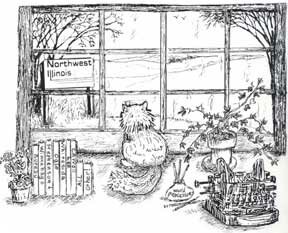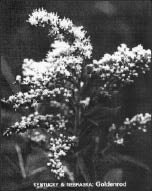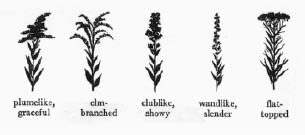
Discover rewarding casino experiences. 

Please Don't Quote Me Among comedians, Rodney Dangerfield claimed he didn’t get no respect. Among Illinois wildflowers one could say that the Goldenrod don’t get no respect either. It’s a late summer and autumn bloomer that’s blamed for causing allergies, hay fever, and it don’t!!! |
Ragweed pollen is thin and wispy and easily carried onto other plants while the Goldenrod’s pollen is heavy, thick, sticky and insect pollinated so far from likely to blow anywhere. Goldenrod is also a seed bearer and propagates by that method, too. The Solidago family of which Goldenrod is a member will thank you to learn of its many properties including not to make you sneeze. There are over one hundred kinds of Goldenrod in North America with five, six, more differing kinds of leaves and arrangements from the stems so to learn them all is a challenge. Nearly every state in the union grows a Solidago variety because it’ll grow in waste places, full sun or deep in a dark forest. It is the state flower of both Kentucky and Nebraska and blooms in some varieties from June until October. You may be surprised to know that Goldenrod comes in cream-color, whitish, brilliant yellow, light yellow and everything in between. To remind you, Ragweed and Ragwort are two different plants if you’re into placing the blame somewhere, the latter having a flower much like a daisy but instead of being white are bright yellow and several stems with flower heads come off the single upright stem with leaves almost like a violet’s.
Ragwort was once more familiarly known as Groundsel of which there are two types in our nation—the European and the American wild. The latter is taller with aster-like flowers. Ragwort has been studied for its medicinal properties since ancient times in places such as Greece and Arabia where, for instance, it was mixed with frankincense into a healing poultice. Of the three Gifts of the Magi, frankincense may have been more valuable than we suppose if it had (some) healing properties that might aid the Christ Child. At the very same time on the opposite side of the globe, Native Americans were also studying the Ragwort/Groundsel and coming up with about the same conclusion. It was used in childbirth to assuage pain and for female complaints. That’s why it was long ago called Squaw Weed when employed by the Native American. With rise of the Anglo-Saxon, their pronunciations changed the sound of the word. (Ragwort’s second syllable, wort, actually means plant). In Groundsel started out as grundeswelge meaning, colorfully, “pus swallower” because when put on boils or abscesses, sores or cuts, it drew out the pus or infection. By the time the Middle English pronunciation came about, Groundsel had become Grundsel, then lost that identity altogether with Ragwort.
But Goldenrod was experimented with for its healing properties and for the fact that it was so plentiful. The Omaha Indians, for instance, would go on month’s long buffalo hunts when seeing the Goldenrod in bloom, would realize it was getting late in the year ... “Now the corn is starting to ripen at home. For us today we know Goldenrod’s blooming is a sign that autumn is on the way.” The only European species is Solidago virgaures or Woundwort for its all-healing “ingredients.” It was used as an astringent to treat ulcers and sores in the mouth. Delaware Indians used Goldenrod for lung trouble, diarrhea, female cramps and complaints, fever. Cherokee Indians used Goldenrod to alleviate bladder and kidney ailments. The Menominees, Ojibway and Potawatomies each used Goldenrod to heal boils. Meskwakee used Goldenrod into a salve for bee stings. Some applied the root directly to an aching tooth or its cavity to relieve the pain. Alabama Indians and the Houma, used certain varieties in a soothing tea. And as long as we’re talking about tea, following the famous Boston Tea Party (the original Tea Party) where some upstarts threw kegs of British imported tea into Boston Harbor and banned the drinking of tea for Colonials, a tea was brewed up by we patriots. Our Goldenrod/Solidago. The flowers and leaves being employed. It was called Liberty tea and/or Mountain tea and drunk with pride and to spite the Brits.
New Englanders used the galls from a Goldenrod’s stem on their person to ward off or cure rheumatism. Galls were caused by insect eggs or larvae weaving a case on the plant. If the larvae were alive, all the better. Although many excellent benefits are said to have been found in the Goldenrod, it is poisonous to grazing sheep and cattle, it containing an element that destroys red blood cells. Rust, a fungus, will develop on the plant which horses may ingest and cause them to die so it isn’t always an innocuous weed. One of our nation’s genius’, Thomas Edison, did limitless experiments using the Goldenrod and actually discovered a substitute for rubber with it. But it proved too economically unsound the idea was dropped. Attention to the Goldenrod was even given by the literate. The following from Recollections of a Tour Made in Scotland by Dorothy Wordsworth.
“August, 1803. We saw before us the hills of Loch Lomond, Ben Lomond and another district by itself ... Traveled some miles along the open country which was all without hedgerows; sometimes marble, sometimes moorish and often whole tracts covered with Groundsel. There was one field that one might have believed had been sown to Groundsel it was so regularly covered and contiguous to it were other fields of the same size and shape planted to potatoes and clover; all equally regular crops. The oddness of this appearance, the Groundsel being uncommonly luxuriant and the field yellow as gold made William laugh (William Wordsworth) and C. (Samuel Taylor Coleridge) melancholy on it, observing that there was land enough (the Groundsel) to rear a healthy child.”
|








